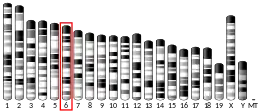TRIL (gene)
KIAA0644, also known as TRIL or TLR4 interactor with leucine rich repeats, is a protein that in humans is encoded by the KIAA0644 gene.[5]
| TRIL | |||||||||||||||||||||||||
|---|---|---|---|---|---|---|---|---|---|---|---|---|---|---|---|---|---|---|---|---|---|---|---|---|---|
| Identifiers | |||||||||||||||||||||||||
| Aliases | TRIL, KIAA0644, TLR4 interactor with leucine rich repeats | ||||||||||||||||||||||||
| External IDs | OMIM: 613356 MGI: 1914123 HomoloGene: 69404 GeneCards: TRIL | ||||||||||||||||||||||||
| |||||||||||||||||||||||||
| |||||||||||||||||||||||||
| |||||||||||||||||||||||||
| Orthologs | |||||||||||||||||||||||||
| Species | Human | Mouse | |||||||||||||||||||||||
| Entrez | |||||||||||||||||||||||||
| Ensembl | |||||||||||||||||||||||||
| UniProt | |||||||||||||||||||||||||
| RefSeq (mRNA) | |||||||||||||||||||||||||
| RefSeq (protein) | |||||||||||||||||||||||||
| Location (UCSC) | Chr 7: 28.95 – 28.96 Mb | Chr 6: 53.82 – 53.82 Mb | |||||||||||||||||||||||
| PubMed search | [3] | [4] | |||||||||||||||||||||||
| Wikidata | |||||||||||||||||||||||||
| |||||||||||||||||||||||||
Function
The exact function of KIAA0644 is not known. It is, however, a member of the leucine-rich repeat family of proteins, which are known to be involved in protein-protein interactions. This protein is known to interact with the TLR4 protein.
TRIL is a component of the TLR4 complex and is induced in a number of cell types by lipopolysaccharide (LPS).[6]
Protein sequence
The main isoform of the human protein is 811 amino long and is composed primarily of leucine (17%), alanine and arginine (~10%), and glycine (~ 8.5%) residues. The protein sequence is predicted to consists mostly of α-helices and a few β-sheet
Homology
KIAA0644 is conserved well among mammals but can be found in all chordates with lower sequence identities.
Gene neighborhood
The KIAA0644 gene is neighbors to mRNA-cAMP responsive element binding gene downstream and mRNA carboxypeptidase and serine carboxypeptidase gene upstream [7][8]
References
- GRCh38: Ensembl release 89: ENSG00000255690 - Ensembl, May 2017
- GRCm38: Ensembl release 89: ENSMUSG00000043496 - Ensembl, May 2017
- "Human PubMed Reference:". National Center for Biotechnology Information, U.S. National Library of Medicine.
- "Mouse PubMed Reference:". National Center for Biotechnology Information, U.S. National Library of Medicine.
- "Entrez Gene: TRIL TLR4 interactor with leucine rich repeats". Retrieved 13 May 2010.
- Carpenter S, Carlson T, Dellacasagrande J, Garcia A, Gibbons S, Hertzog P, Lyons A, Lin LL, Lynch M, Monie T, Murphy C, Seidl KJ, Wells C, Dunne A, O'Neill LA (September 2009). "TRIL, a functional component of the TLR4 signaling complex, highly expressed in brain". J. Immunol. 183 (6): 3989–3995. doi:10.4049/jimmunol.0901518. PMID 19710467.
- "NCBI Entrez". Retrieved 13 May 2010.
- Ishikawa K, Nagase T, Suyama M, Miyajima N, Tanaka A, Kotani H, Nomura N, Ohara O (June 1998). "Prediction of the coding sequences of unidentified human genes. X. The complete sequences of 100 new cDNA clones from brain which can code for large proteins in vitro". DNA Res. 5 (3): 169–176. doi:10.1093/dnares/5.3.169. PMID 9734811.
Further reading
- Strausberg RL, Feingold EA, Grouse LH, et al. (2002). "Generation and initial analysis of more than 15,000 full-length human and mouse cDNA sequences". Proc. Natl. Acad. Sci. U.S.A. 99 (26): 16899–16903. doi:10.1073/pnas.242603899. PMC 139241. PMID 12477932.
- Scherer SW, Cheung J, MacDonald JR, et al. (2003). "Human Chromosome 7: DNA Sequence and Biology". Science. 300 (5620): 767–772. doi:10.1126/science.1083423. PMC 2882961. PMID 12690205.
- Büssow K, Cahill D, Nietfeld W, et al. (1998). "A method for global protein expression and antibody screening on high-density filters of an arrayed cDNA library". Nucleic Acids Res. 26 (21): 5007–5008. doi:10.1093/nar/26.21.5007. PMC 147919. PMID 9776767.
- Wheeler HE, Metter EJ, Tanaka T, et al. (2009). Gibson G (ed.). "Sequential Use of Transcriptional Profiling, Expression Quantitative Trait Mapping, and Gene Association Implicates MMP20 in Human Kidney Aging". PLOS Genet. 5 (10): e1000685. doi:10.1371/journal.pgen.1000685. PMC 2752811. PMID 19834535.
This article incorporates text from the United States National Library of Medicine, which is in the public domain.




